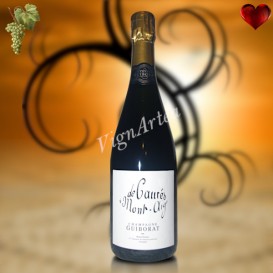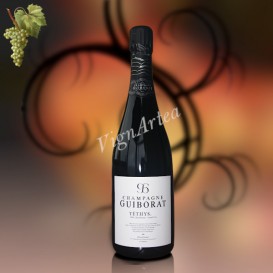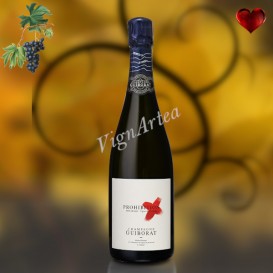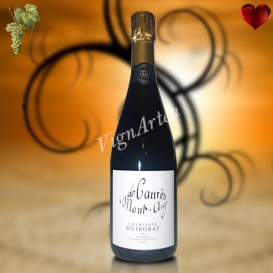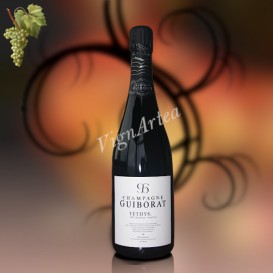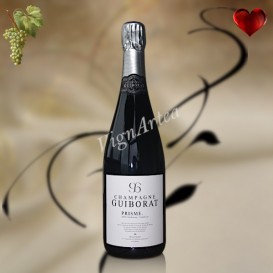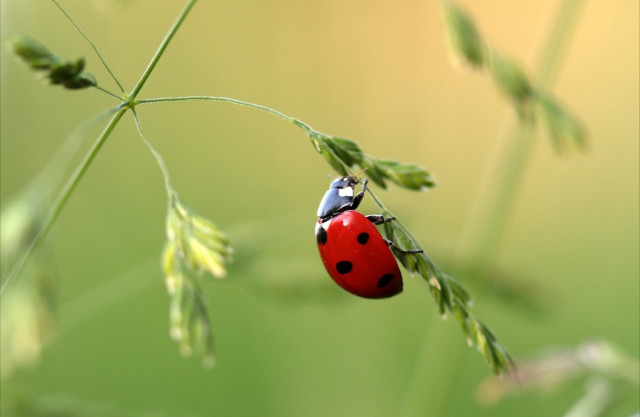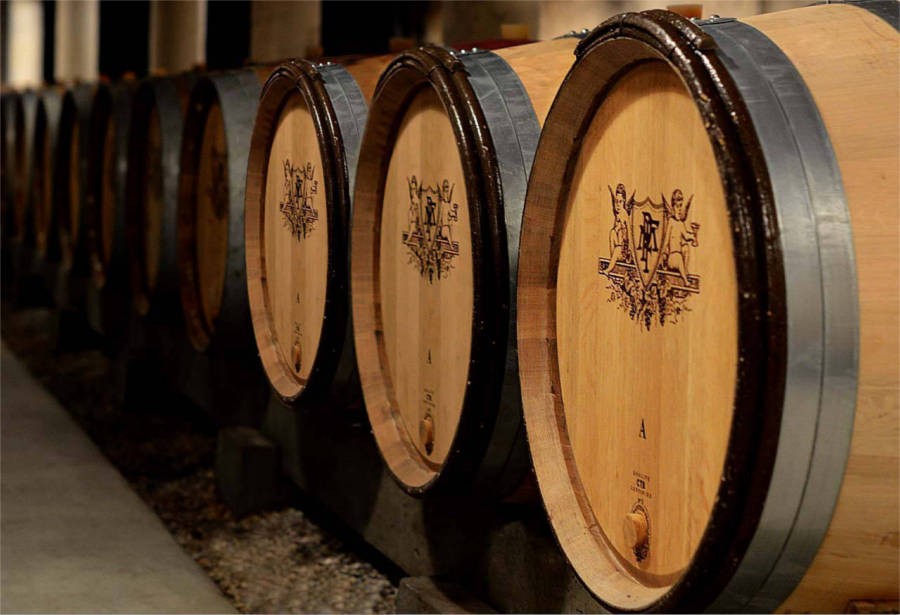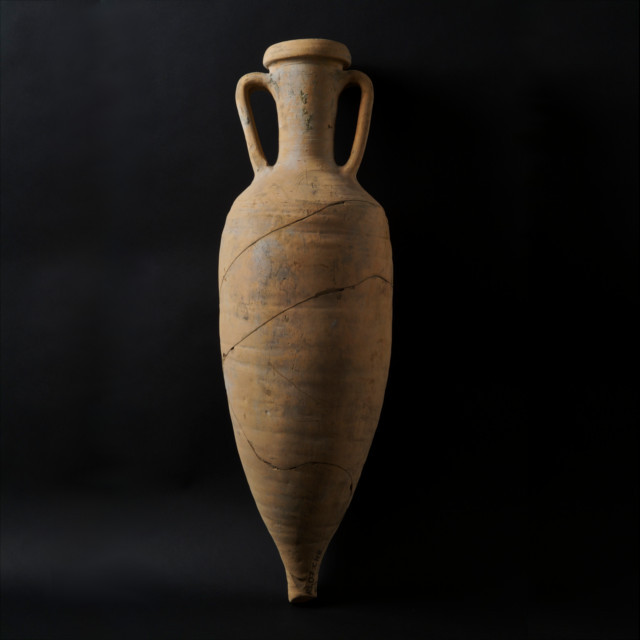Champagne GUIBORAT

CHAMPAGNE CÔTE DES BLANCS 3 ha SUSTAINABLE AGRICULTURE WINEMAKER : Richard FOUQUET
ESTATE STORY
The GUIBORAT CHAMPAGNE Estate is located in the heart of Cramant, a classified Grand Cru village of Champagne, where the wines have for a long time a strong reputation. Richard Fouquet and his wife Karine, the owners, have 8 hectares of vineyards but they only grow 3 hectares, the remaining surface being used by the Lauret Perrier Champagne Estate.
Born in Paris, Richard took over the formerly run by the grandmother's domain when he was 18 and produced his first vintage in 1996.
TERROIR
The Côte des Blancs is framed by the Saran hillock to the north and by the Mount Aimé to the south. The slopes are gentle at the beginning, less than 8%, but become steeper and steeper and can reach up to 40% at the top of the hillside. The vines in this region are essentially based on Campanian chalk (Upper Cretaceous period from 83 to 70 Ma) and its alterations (chalk gravels).
The Upper Cretaceous is marked by a major transgression due to a general rise in the sea level: the waters arrive from the north-west and cover the Paris basin to the north and the Aquitaine basin to the south, without these two basins meeting. The transgression therefore remains weaker than the one encountered during the Jurassic area.
The Campanian chalk is made up of a pile of microscopic unicellular algae skeletons, sedimented in warm, shallow sea conditions, and forming a calcareous mud that gradually settled over millions of years.
In the Côte des Blancs, the chalk is very pure and has a high porosity which makes it friable and gives it a high water retention capacity. These properties ensure a good soil drainage and a regular water supply for the vines during the summer.
Its other advantage lies in its thermal and hygrometric regulation qualities, which are ideal for the wine conservation in the cellars.
WINEGROWING & WINEMAKING
There is no organic certification at Guiborat Estate. But the vines are grown according to the principles of organic farming, without using any chemicals. Treatments are generally based on herbal teas and essential oils. Richard Fouquet departs from this principle only if the weather is bad, when he has to cope with nature and to use chemicals to save the crops. An independence that is dear to him yet deprives him of any official certification.
The vines are 30 to 70 years old, and are planted on parcels shared on the classified Grand Cru communes of Cramant, Oiry, and Chouilly, next to the Saran hill.
Richard Fouquet makes a plot's vinification, meaning that the grapes of each plot are all fermented in separate vats or barrels. But the champagnes are generally made of a blend of plots, except for the exceptional vintages that are also plot's wine (made from grapes of a single plot): this is the case for the champagne Mont-Aigu.
Richard and Karine Fouquet do not cheat with the plot's designation of their cuvees: strict and honest, they classified the wine as a plot's one only if they consider the latest deserves it.
Their champagne's profile is unique. They are wines without any artifices and rarely marked by the wood. A style that they are constantly fine-tuning, little by little, and are trying to make as pur as possible: if for the former wines, the malolactic fermentation were done, the current wines did not the malolactic fermentation. They are classified as Extra-Brut, or Brut Nature when there is no addition of liquor: they are sapid and straight champagnes, a beautiful work!
-
DE CAURÉS À MONT-AIGÜ 2017 (Champagne Guiborat)
90,00 € In stock!CÔTE DES BLANCS - AOP CHAMPAGNE - VINTAGE BLANC DE BLANCS CHAMPAGNE
Grape variety: Chardonnay (100%)
Extra Brut Grand Cru Vintage
Sugar addition: 1,5 g/lRich - Fresh - Complex - Elegant
- Nose: fresh and elegant. Chalky notes, scents of lemon, white grapefruit, green apples with a hint of verbena.
- Palate: invigorating, salivating and fresh. Well-balanced with controlled tension. Delicate bubbles. Lemony finish.
- Tasting date: December 2024.
- OUR OPINION: a vintage of great freshness and purity. Well-drawn, with elegance and voluptuousness. A rich, complex top-of-the-range Champagne I've fallen in love with! ❤️❤️
Other vintages available :
The exceptional bottle's weight (1.8kg) may result in higher shipping costs for the final shopping cart.
- Nose: fresh and elegant. Chalky notes, scents of lemon, white grapefruit, green apples with a hint of verbena.
-
TETHYS 2021 (Champagne Guiborat)
45,00 € In stock!CÔTE DES BLANCS - AOP CHAMPAGNE - BLANC DE BLANCS CHAMPAGNE
Grape variety: Chardonnay (100%)
Extra Brut Grand Cru Sugar addition: 1,5 g/l
Tonic - Complex - Racy
- Nose: fresh and slightly chalky. Notes of lemon and praline, with a hint of green apple and verbena.
- Palate: invigorating and aromatic. Fine bubbles, with a long, salivating finish.
- Tasting date: December 2024.
- OUR OPINION: 2021 is a livelier, tauter vintage than 2020. It is perfectly balanced, with lovely tension and complexity. 2021 is more mineral than fruity. It's very fresh and thirst-quenching!
Other blend available:
2020
The exceptional bottle's weight (1.8kg) may result in higher shipping costs for the final shopping cart.
- Nose: fresh and slightly chalky. Notes of lemon and praline, with a hint of green apple and verbena.
-
PROHIBITION R-20 (Champagne Guiborat)
51,90 € In stock!MARNE VALLEY - AOP CHAMPAGNE - BLANC DE NOIRS CHAMPAGNE
Grape variety: Pinot Meunier (100%)
Brut Nature Non vintage
Elegant - Racy - Fruity
- Color: slightly pinkish yellow.
- Nose: open and generous. Notes of white flowers, pink grapefruit and redcurrant.
- Palate: delicate, fresh and salivating. Very beautiful tension on the palate, with long-lasting aromas.
Tasting date: April 2024.- OUR OPINION: S-U-P-E-R-B! Such an elegance and a class! This Pinot Meunier is fresh, perfectly balanced and chiselled to perfection. What a delight!
The exceptional bottle's weight (1.8kg) may result in higher shipping costs for the final shopping cart.
- Color: slightly pinkish yellow.
-
DE CAURÉS À MONT-AIGÜ 2016 (Champagne Guiborat)
89,00 € In stock!CÔTE DES BLANCS - AOP CHAMPAGNE - VINTAGE BLANC DE BLANCS CHAMPAGNE
Grape variety: Chardonnay (100%)
Extra Brut Grand Cru Vintage Sugar addition:1,5 g/l
Complex - Fresh - Tense
- Nose: Intense, fresh and highly complex. Notes of lemon, citron, pink grapefruit, white flowers, green apple and almond.
- Palate: salivating and fresh, delicate and mineral. Lime zest finish.
- Tasting date: October 2023.
- OUR OPINION: as exceptional as ever, this wine charms with its elegance and aromatic complexity, and has a lovely tension on the palate. A magical moment for lovers of tense champagnes.
Other vintage available:
The exceptional bottle's weight (1.8kg) may result in higher shipping costs for the final shopping cart.
- Nose: Intense, fresh and highly complex. Notes of lemon, citron, pink grapefruit, white flowers, green apple and almond.
-
TETHYS 2020 (Champagne Guiborat)
44,00 € In stock!CÔTE DES BLANCS - AOP CHAMPAGNE - BLANC DE BLANCS CHAMPAGNE
Grape variety: Chardonnay (100%)
Extra Brut Grand Cru Sugar addition: 1,5 g/l
Nice - Perfumed - Rich
- Nose: fresh and generous. Notes of green apple, lemon and pink grapefruit, with a hint of hazelnut and fennel.
- Palate: wrapping and invigorating, flavoursome and pleasantly fragrant.
- Tasting date: October 2023.
- OUR OPINION: a very pleasant champagne, a successful vintage with a generous perfume. Superb!
Other blend available:
The exceptional bottle's weight (1.8kg) may result in higher shipping costs for the final shopping cart.
- Nose: fresh and generous. Notes of green apple, lemon and pink grapefruit, with a hint of hazelnut and fennel.
-
PRISME 18 (Champagne Guiborat)
59,50 € In stock!CÔTE DES BLANCS - AOP CHAMPAGNE - BLANC DE BLANCS CHAMPAGNE
Grape variety: Chardonnay (100%)
Extra Brut Grand Cru Sugar addition: 1,5 g/l
Complex - Fresh - Well-balanced
- Nose: lively and elegant. Notes of brioche, almond paste and citrus fruit
- Palate: lively and elegant. Notes of brioche, almond paste and citrus fruit
- Tasting date: October 2023
- OUR OPINION: a very fresh and complex vintage, perfectly balanced, with an elegant tension!
The exceptional bottle's weight (1.8kg) may result in higher shipping costs for the final shopping cart.
- Nose: lively and elegant. Notes of brioche, almond paste and citrus fruit

